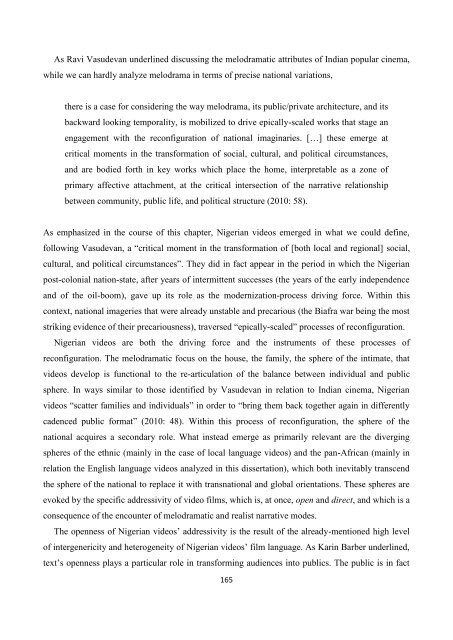Create successful ePaper yourself
Turn your PDF publications into a flip-book with our unique Google optimized e-Paper software.
As Ravi Vasudevan underlined discussing the melodramatic attributes of Indian popular cinema,while we can hardly analyze melodrama in terms of precise national variations,there is a case for considering the way melodrama, its public/private architecture, and itsbackward looking temporality, is mobilized to drive epically-scaled works that stage anengagement with the reconfiguration of national imaginaries. […] these emerge atcritical moments in the transformation of social, cultural, and political circumstances,and are bodied forth in key works which place the home, interpretable as a zone ofprimary affective attachment, at the critical intersection of the narrative relationshipbetween community, public life, and political structure (2010: 58).As emphasized in the course of this chapter, Nigerian videos emerged in what we could define,following Vasudevan, a “critical moment in the transformation of [both local and regional] social,cultural, and political circumstances”. They did in fact appear in the period in which the Nigerianpost-colonial nation-state, after years of intermittent successes (the years of the early independenceand of the oil-boom), gave up its role as the modernization-process driving force. Within thiscontext, national imageries that were already unstable and precarious (the Biafra war being the moststriking evidence of their precariousness), traversed “epically-scaled” processes of reconfiguration.Nigerian videos are both the driving force and the instruments of these processes ofreconfiguration. The melodramatic focus on the house, the family, the sphere of the intimate, thatvideos develop is functional to the re-articulation of the balance between individual and publicsphere. In ways similar to those identified by Vasudevan in relation to Indian cinema, Nigerianvideos “scatter families and individuals” in order to “bring them back together again in differentlycadenced public format” (2010: 48). Within this process of reconfiguration, the sphere of thenational acquires a secondary role. What instead emerge as primarily relevant are the divergingspheres of the ethnic (mainly in the case of local language videos) and the pan-African (mainly inrelation the English language videos analyzed in this dissertation), which both inevitably transcendthe sphere of the national to replace it with transnational and global orientations. These spheres areevoked by the specific addressivity of video films, which is, at once, open and direct, and which is aconsequence of the encounter of melodramatic and realist narrative modes.The openness of Nigerian videos’ addressivity is the result of the already-mentioned high levelof intergenericity and heterogeneity of Nigerian videos’ film language. As Karin Barber underlined,text’s openness plays a particular role in transforming audiences into publics. The public is in fact165
















